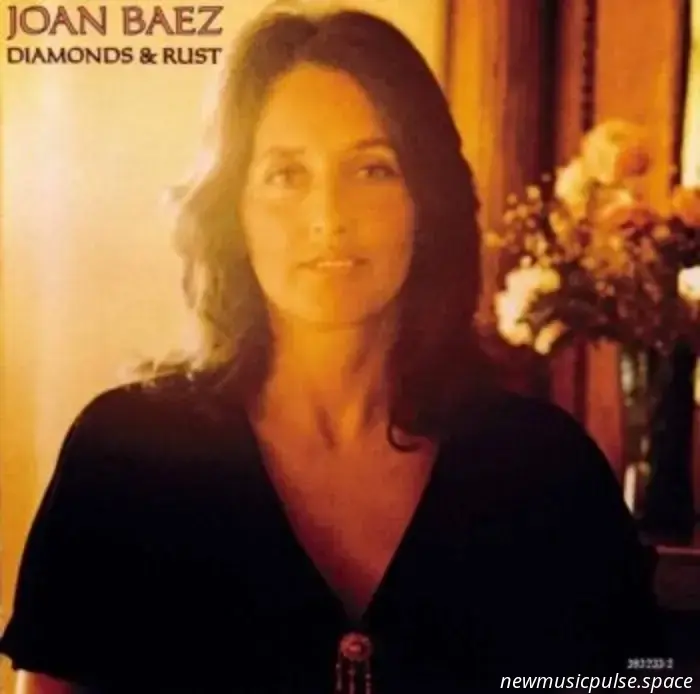
Discovering the enduring sorrow in Joan Baez’s iconic song “Diamonds and Rust” fifty years after its debut – and still resonating with every lyric.
Listen: “Diamonds and Rust” – Joan Baez
When the memories of the past resurface to trouble us – and they inevitably do – a typical response is to push those painful recollections into the deepest recesses of our mind. We tend to ignore the memories, hoping they will fade away. But what occurs when these recollections are brought to light and thoroughly examined? What happens when we muster the resolve to confront feelings we have long suppressed? Often, art emerges when we allow pain to flow through us until it transforms into something beautiful. Joan Baez’s exquisite, haunting song “Diamonds and Rust” epitomizes this — a gem crafted from lost love and rekindled pain. Before we explore what makes this song remarkable, let’s take a closer look at the phenomenal artist behind it.
Joan Baez is a pivotal figure in American folk music. If her name wasn’t familiar to you before (no judgement), you may have recognized her after the recent release of the Bob Dylan biopic A Complete Unknown, which depicted her complex personal and professional relationship with Dylan. Baez played a crucial role in Dylan’s early success, having already established herself in the music scene as one of the first prominent musicians to feature in one of his records. She even invited a then-unknown Dylan to perform during one of her sets in the summer of 1963. Their careers remained intertwined for decades. However, she began her journey years earlier at the inaugural Newport Folk Festival in 1959, quickly gaining fame thereafter. The festival, closely associated with protest and counterculture, provided an ideal platform for Baez to make her public debut. A lifelong activist, she participated in the Civil Rights movement and attended various nonviolent protests organized by Martin Luther King Jr., including the march from Selma to Montgomery in 1965. Throughout her career, she has utilized her platform as a means of protest and resistance, advocating for prison reform, LGBTQI+ rights, environmental conservation, and numerous other noble causes. She has consistently spoken out against injustice since before achieving fame and continues to do so today.
Diamonds & Rust – Joan Baez
Throughout the ’60s, Baez released fourteen albums, becoming a symbol of the American roots revival and inspiring other notable artists like Joni Mitchell and Bonnie Raitt. Her fame surged in 1969 after her performance at the legendary Woodstock, where “Sweet Sir Galahad” (another incredibly beautiful piece) was the only original song she presented during her set. While introducing it, she told the audience that she was “just smart enough to know her writing is very mediocre.”
That performance revealed her self-critical remarks to be unjustified, and time would show just how misguided that sentiment was. Initially, she gained recognition for her reinterpretations and adaptations of others’ music, but as the 70s approached, she began composing more of her original songs. This artistic evolution led to the release of her 1975 album Diamonds & Rust, with its title track becoming a pop success that reached the U.S. top forty after being released as a single earlier that year.
“Diamonds and Rust” will linger with you in the best possible manner. It begins with soft, folky guitar chords, drawing you into a realm of heartache and nostalgia for moments that have passed. The gentle instrumentals invite you in, pulling you from your refuge and into the dreamy allure of the song. As the cymbals quietly shimmer with their invitation, you cannot help but accept. Speaking of haunting, the lyrics perfectly capture the emotions the song evokes:
Well, I’ll be damned
Here comes your ghost again
But that’s not unusual
It’s just that the moon is full
And you happened to call
And here I sit
Hand on the telephone
Hearing a voice I’d known
A couple of light years ago
Heading straight for a fall
The song takes you to the edge of deep feelings, threatening to engulf you in emotions you believed were long buried. It is deeply personal yet universally relatable; grounding the listener while elevating them to a higher state of awareness and introspection. Much like the specter of a former lover, “Diamonds and Rust” refuses to be forgotten or dismissed. While it has long been speculated that the song refers to Bob Dylan, it was only years later that Baez confirmed this in an interview. She had been working on a different song entirely until she received a phone call from Dylan (from a booth in the Midwest), inspiring her to change her artistic direction and create this masterpiece. However — while decades-old gossip may be entertaining — the true inspiration behind the song is perhaps the least captivating aspect. The beauty of music lies in personal interpretation; using a song as a means to reflect on



Reflecting on the enduring sorrow of Joan Baez’s iconic song “Diamonds and Rust” fifty years after its debut – and still resonating with every line.